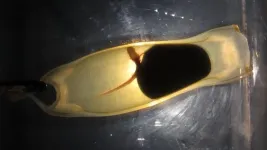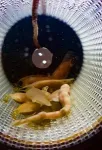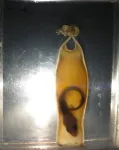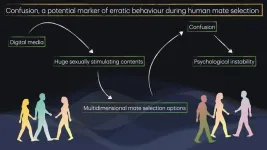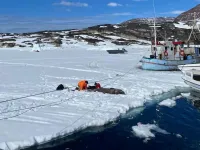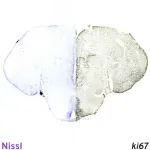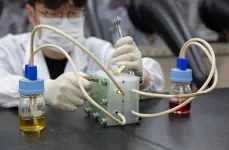(Press-News.org) New experimental research shows that the combined effects of ocean warming and acidification could lead to a catastrophic decrease in embryonic shark survival by the year 2100. This research is also the first to demonstrate that monthly temperature variation plays a prominent role in shark embryo mortality.
Oceanic warming and acidification are caused by greater concentrations of CO2 dissolving into marine environments, resulting in rising water temperatures and falling pH levels. “The embryos of egg-laying species are especially sensitive to environmental conditions,” says Noémie Coulon, a PhD student at the Laboratoire de Biologie des Organismes et des Écosystèmes Aquatiques, France. “The hatching success of embryos is a crucial factor for population dynamics. In the case of skates and sharks, which have a slow pace of life, low hatching rates could be critical for population renewal.”
Small-spotted catsharks (Scyliorhinus canicula) are one of the most abundant shark species in Europe. “The small-spotted catshark is already experiencing habitat loss in coastal areas, particularly during the summer months when egg-laying is at its peak,” says Ms Coulon.
Ms Coulon and her team compared small-spotted catshark embryo survival in three environmental scenarios: one control scenario using baseline temperature and pH data from the years 1995 to 2014, and two using predicted climate scenarios for the year 2100 called the Shared Socioeconomic Pathways (SSPs) as outlined in the United Nations’ Intergovernmental Panel on Climate Change’s Sixth Assessment Report released in 2021.
SSP2, known as the “Middle of the Road” scenario, represents a future where slow and non-uniform progress towards tackling climate change is present but net-zero is not reached, and predicts a temperature rise of 2.7°C and drop in pH of 0.2 by the year 2100.
SSP5, known as the “Fossil-fueled Development” scenario, represents a future where fossil fuel resources continue to be more rapidly exploited across the world, and predicts a temperature rise of 4.4°C and drop in pH of 0.4 by the year 2100.
To assess the impact of these different scenarios, Ms Coulon and her team measured embryo growth and yolk consumption within small-spotted catshark eggs every week over a 4-month period, while recording hatching success and growth of surviving baby sharks for 6 months post-hatching.
While the team found a high survival rate for both the control and SSP2 scenarios (81% and 83% respectively), there was a much lower chance of survival for the SSP5 scenario. “We were shocked by the low survival rate observed in the SSP5 scenario, with only 11% of embryos hatching,” says Ms Coulon. The team indicated that the mortality was linked with lower yolk consumption rates, lower growth rates and failure to transition to internal gills.
This research also highlights the importance of seasonal temperature variation, which can significantly increase mortality during critical egg laying periods. “This mortality was most pronounced in August, coinciding with the highest temperatures (reaching 23.1°C), and during a stage of development where embryos undergo gill reabsorption,” explains Ms Coulon.
Ms Coulon and her team noticed that the surviving 11% did not exhibit the typical growth pattern of the other sharks, which may have contributed to their resistance to environmental change: “What makes these individuals special remains unclear, but by acknowledging the inter-individual variation among young marine organisms, we could better evaluate the future ecological success of species.”
This research offers both a serious caution and a beacon of hope for marine species. “Firstly, it serves as a warning about the responses of other species that may be even more sensitive to environmental change,” explains Ms Coulon. “Secondly, our findings demonstrate that the more moderate SSP2 scenario can limit the damage inflicted on species like the small-spotted catshark, which gives us a positive incentive to reduce our greenhouse gas emissions.”
This project has received funding support from the Save Our Seas Foundation. More information can be found here: https://saveourseas.com/project/bringing-up-baby-shark-embryos-and-our-warming-oceans.
This research is being presented at the Society for Experimental Biology Annual Conference in Prague on the 2-5th July 2024.
END
Shark hatching success drops from 82% to 11% in climate change scenario
2024-07-03
ELSE PRESS RELEASES FROM THIS DATE:
Meet the team 3D modelling France’s natural history collections
2024-07-03
France’s natural history collections contain nearly 6% of the world’s total natural specimens across multiple institutions, and the e-COL+ project aims to capture and reconstruct these specimens in 3D for easy access and 3D printing around the world.
“I’m a researcher of vertebrate locomotion and vocalisation, so I produce a lot of CT scans and 3D models – and now I’m in charge of developing the museum’s own 3D digital collection,” ...
Artificial light is a deadly siren song for young fish
2024-07-03
New research finds that artificial light at night (ALAN) attracts larval fish away from naturally lit habitats, while dramatically lowering their chances of survival in an “ecological trap”, with serious consequences for fish conservation and fishing stock management.
“Light pollution is a huge ongoing subject with many aspects that are still not well understood by scientists,” says Mr Jules Schligler, a PhD student at CRIOBE Laboratory (Centre de Recherches Insulaires et Observatoire de l’Environnement) in Moorea, French Polynesia.
ALAN is the product of human-related ...
Social media is a likely cause of ‘confusion’ in modern mate selection
2024-07-03
A recent sociological study finds that most young adults surveyed reported feeling confused about their options when it comes to dating decisions. Preliminary analysis suggests that more than half of young people experience confusion about choosing life-partners, with women appearing to be more likely to report partner selection confusion than men.
Due to the pervasiveness of social media and digital dating in everyday lives, humans are now exposed to many more potential mates than ever before, but the availability of popular dating apps ...
Exploring bird breeding behaviour and microbiomes in the radioactive Chornobyl Exclusion Zone
2024-07-03
New research finds surprising differences in the diets and gut microbiomes of songbirds living in the radiation contaminated areas of the Chornobyl Exclusion Zone, Ukraine. This study is also the first to examine the breeding behaviour and early life of birds growing up in radiologically contaminated habitats.
The Chornobyl Exclusion Zone (Ukrainian), also known as the Chernobyl Exclusion Zone (Russian), is an area of approximately 2,600 km2 of radiologically contaminated land that surrounds the Chornobyl Nuclear Power Plant. The levels of contamination are uneven throughout the zone.
“The ...
Discovering new anti-aging secrets from the world’s longest-living vertebrate
2024-07-03
New experimental research shows that muscle metabolic activity may be an important factor in the incredible longevity of the world’s oldest living vertebrate species – the Greenland shark. These findings may have applications for conservation of this vulnerable species against climate change or even for human cardiovascular health.
Greenland sharks (Somniosus microcephalus) are the longest living vertebrate with an expected lifespan of at least 270 years and possible lifespan beyond 500 years. “We want to understand what adaptations ...
Pregnant fish can also get “baby brain”, but not the way that mammals do
2024-07-03
New research reveals that pregnancy-related brain impairment is present in live-bearing fish, but instead of affecting learning and memory as expected from similar research on mammals, it appears to have a stronger impact on decision-making and sensory reception.
There have been many studies into the detrimental impact of pregnancy on mammalian brains, sometimes called “baby brain” or “momnesia” in humans, revealing how the disruption of neurological processes like neurogenesis, or the creation ...
Pasteurization inactivates highly infectious avian flu in milk
2024-07-03
Highlights:
• In late March 2024, H5N1 bird flu was detected in dairy cattle and then in raw milk.
• Researchers tested hundreds of milk products from dozens of states for the virus.
• No infectious virus was found in pasteurized milk products.
• Non-infectious traces of viral genetic material were found in 20% of samples.
Washington, D.C.—In March 2024, dairy cows in Texas were found to be infected with highly pathogenic avian flu, ...
KIER develops 'viologen redox flow battery' to replace vanadium’
2024-07-03
A technology has been developed to replace the active material in large-capacity ESS 'redox flow batteries' with a more affordable substance.
*Redox Flow Battery: A term synthesized from Reduction, Oxidation, and Flow. It is a battery that stores electrical energy as chemical energy through oxidation and reduction reactions of active materials in the electrolyte at the electrode surface and converts it back to electrical energy when needed. It is capable of large-scale storage, can be used long-term through periodic replacement of the electrolyte, and its major advantage is the absence of fire risk.
Dr. Seunghae Hwang’s ...
Chemists synthesize an improved building block for medicines
2024-07-03
Chemists have overcome a major hurdle in synthesizing a more stable form of heterocycle—a family of organic compounds that are a common component of most modern pharmaceuticals.
The research, which could expand the toolkit available to drug developers in improving the safety profiles of medications and reducing side effects, was published in Science by organic chemists at the University of British Columbia (UBC), the Massachusetts Institute of Technology (MIT), and the University of Michigan.
“Azetidines ...
A genetic algorithm for phononic crystals
2024-07-03
Tokyo, Japan – The advent of quantum computers promises to revolutionize computing by solving complex problems exponentially more rapidly than classical computers. However, today's quantum computers face challenges such as maintaining stability and transporting quantum information. Phonons, which are quantized vibrations in periodic lattices, offer new ways to improve these systems by enhancing qubit interactions and providing more reliable information conversion. Phonons also facilitate better communication ...
